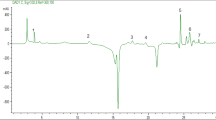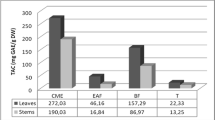Abstract
The work was conducted with the purpose to evaluate antioxidant activity of Parmelia saxatilis (PS) by different analytical methods. Water and methanol were used as solvents and antioxidative effects were measured by a ferric thiocyanate method (FTC) and thiobarbituric acid test (TBA). The antioxidant activity increased with the increasing amount of extracts (from 50 to 250 µg) added to linoleic acid emulsion. The methanol extract of PS exhibited high antioxidative activity that was not significantly (P < 0.05) different from α-tocopherol, while aqueous extracts of PS showed low antioxidative activity. Similar trends of antioxidant activity were observed using either the FTC or TBA methods. Antioxidant activity, reducing power, free radical scavenging (DPPH·), superoxide anion radical scavenging, metal chelating and hydrogen peroxide scavenging activities of PS extracts showed dose dependence and increased with concentration of PS extract. The results obtained in the present study indicate that the PS might be a potential source of natural antioxidant.
Similar content being viewed by others
References
Andlauer W. & Fürst P. 1998. Antioxidative power of phytochemicals with special reference to cereals. Cereal Foods World 43: 356–359.
Bayir Y., Odabasoglu F., Cakir A., Aslan A., Suleyman H., Halici M. & Kazaz C. 2006. The inhibition of gastric mucosal lesion, oxidative stress and neutrophil-infiltration in rats by the lichen constituent diffractaic acid. Phytomed. 13: 584–590.
Baytop T. 1999. Therapy with Medicinal Plants in Turkey (Past and Present). Istanbul University, Istanbul, 233 pp.
Behera B.C., Verma N., Sonone A. & Makhija U. 2006. Determination of antioxidative potential of lichen Usnea ghattensis in vitro. Lebensmit. Wissen. Technol. 39: 80–85.
Cos P., Ying L.Y., Calomme, M., Hu J.H., Cimanga K., Van Poel B., Pieters L., Vlietinck A.J. & Berghe D.V. 1998. Structure activity relationships and classification of flavonoids as inhibitors of xanthine oxidase and superoxide scavengers. J. Natur. Prod. 61: 71–76.
Cotelle N., Bemier J.L., Catteau J.P., Pommery J., Wallet J.C. & Gaydou E.M. 1996. Antioxidant properties of hydroxyl-flavones. Free Rad. Biol. Med. 20: 35–43.
Dinis T.C.P., Madeira V.M.C. & Almeida L.M. 1994. Action of phenolic derivatives (acetaminophen, salicylate and 5-aminosalicylate) as inhibitors of membrane lipid peroxidation as peroxyl radical scavenging effects. Chem. Pharm. Bull. 36: 2090–2097.
Diplock A.T. 1997. Will the ‘good fairies’ please proves to us that vitamin E lessens human degenerative of disease? Free Rad. Res. 27: 511–532.
Duh P.D., Tu Y.Y. & Yen G.C. 1999. Antioxidant activity of aqueous extract of harnjyur (Chyrsanthemum morifolium Ramat). Lebensm. Wissensch. Technol. 32: 269–277
Germano M.P., Pasquale D.E.R., D’Angelo V., Catania S., Silvaria V. & Costa C. 2002. Evaluation of extracts and isolated fraction from Capparis spinosa L. Buds as an antioxidant source. J. Agri. Food Chem. 50: 1168–1171.
Gülçin I., Oktay M., Küfrevioğlu Ö.I. & Aslan A. 2002. Determination of antioxidant activity of lichen Cetraria islandica (L.) Ach. J. Ethnopharmacol. 79: 325–329.
Grice H.C. 1986. Safety evaluation of butylated hydroxytoluene (BHT) in the liver, lung and gastrointestinal tract. Food Chem. Toxicol. 24: 1127–1130.
Haber & Weiss 1934. The catalytic decomposition of hydrogen peroxide by iron salts, Proc. Royal Soc. London 147: 332–351.
Hall C.A. & Cuppett S.L. 1997. Structure-activities of natural antioxidants, pp. 141–170). In: Auroma O.I. & Cuppett S.L. (eds), Antioxidant methodology in vivo and in vitro concepts. AOCS Press, Champaign, IL.
Halliwell B. 1991. Reactive oxygen species in living systems: source, biochemistry, and role in human disease. Amer. J. Med. 91(Suppl. 3C): 14–22.
Hana D., Matsumarua K., Rettorib D. & Kaplowitza N. 2004. Usnic acid-induced necrosis of cultured mouse hepatocytes: inhibition of mitochondrial function and oxidative stress. Biochem. Pharmacol. 67: 439–451.
Hatano T., Edamatsu R., Hiramatsu M., Moti A., Fujita Y., Yasuhara T., Yoshida T. & Okuda T. 1989. Effects of tannins and related polyphenols on superoxide anion radical, and on 1,1-diphenyl-2-picrylhydrazyl radical. Chem. Pharm. Bull. 37: 2016–2021.
Hidalgo M.E., Fernandez E., Quilhot W. & Lissi E. 1994. Antioxidant activity of depsides and depsidones. Phytochem. 37: 1585–1587.
Ingolfsdottir K., Chung G.A., Skulason V.G., Gissurarson S.R. & Vilhelmsdottir M. 1999. Antimycobacterial activity of lichen metabolites in vitro. Eur. J. Pharm. Sci. 62: 141–144.
Jayaprkasha G.K. & Jaganmohan Rao L. 2000. Phenolic constituents from the lichen ‘Parmotrema stuppeum’ hale and their antioxidant activity. Zeitsch. für Naturf. 55: 1018–1022.
Kikizaki H & Nakatani N 1993. Antioxidant effects of some ginger constituents. J. Food Sci. 58: 1407–1410.
Kumar K.C. & Muller K. 1999a. Lichen metabolites. 2. Antiproliferative and cytotoxic activity of gyrophic, usnic, and diffractaic acid in human keratinocyte growth. J. Nat. Prod. 62: 821–823
Kumar K.C. & Muller K. 1999b. Lichen metabolites. 1. Inhibitory Inhibitory action against leucotriene B4 biosynthesis by a non-redox mechanism. J. Nat. Prod. 62: 817–820.
Laranjinha J., Vieira O., Madeira V. & Almeida L. 1995. Two related phenolic antioxidants with opposite effects on vitamin E content in low density lipoproteins oxidized by ferrylmyoglobin: consumption versus regeneration. Arch. Biochem. Biophys. 323: 373–381.
Matthaus B. 2002. Antioxidant activity of extracts obtained from residues of different oilseeds. J. Agric. Food Chem. 50: 3444–3452.
Meir S., Kanner J., Akiri B. & Hadas S.P. 1995. Determination and involvement of aqueous reducing compounds in oxidative defense systems of various senescing leaves. J. Agr. Food Chem. 43: 1813–1817.
Mitsuda H., Yuasumoto K. & Iwami K. 1966. Antioxidation action of indole compounds during the autoxidation of linoleic acid. Eiyo to Shokuryo 19: 210–214.
Modenesi P., Piana M. & Pinna D. 1998. Surface features in Parmelia sulcata (Lichenes) thalli growing in shaded or exposed habitat. Nova Hedvigia 66: 535–547.
Monnet F., Bordas F., Deluchat V. & Baudu M. 2006. Toxicity of copper excess on the lichen Dermatocarpon luridum: Antioxidant enzyme activities. Chemosphere 65: 1806–1813.
Moure A., Franco D., Sineiro J., Dominguez H., Numez M.J. & Lema J.M. 2000. Evaluation of extracts from Guvuina avellana hulls as antioxidants. J. Agric. Food Chem. 48: 3890–3897.
Nash T.H. 1996. Lichen biology. Cambridge University Press, Great Britain, 289 pp.
Nishimiki M., Rao N.A. & Yagi K. 1972. The occurrence of superoxide anion in the reaction of reduced phenazine methosulfate and molecular oxygen. Biochem. Biophy. Res. Com. 46: 849–853.
Odabasoglu F., Aslan A., Cakir A., Suleyman H., Karagoz Y., Halici M. & Bayir Y. 2004. Comparision of antioxidant activity and phenolis content of three lichen species. Phytother. Res. 18: 938–941.
Soktay M., Gulcin I. & Kufrevioglu O.I. 2003. Determination of in vitro antioxidant activity of fennel (Foeniculum vulgare) seed extracts. Food Sci. Technol. 36: 263–271.
Oyaizu M. 1986. Studies on products of browing reaction: Antioxidative activity of product of browing reaction preapared from glucosamine. Jap. J. Nurtion. 44: 307–315.
Ruch R.J., Cheng S.J. & Klaunig J.E. 1989. Prevention of cytotoxicity and inhibition of intracellular communication by antioxidant catechins isolated from Chinese green tea. Carcinogenesis 10: 1003–1008.
Slinkard K. & Singleton V.L. 1977. Total phenol analyses: Automation and comparison with manual methods. Amer. J. Enol. Viticul. 28: 49–55.
Tanaka M., Kuei C.W., Nagashima Y. & Taguchi T. 1998. Application of antioxidative maillrad reaction products from histidine and glucose to sardine products. Nippon Suisan Gakkaishi 54: 1409–1414.
Van Acker S.A.B.E., Van Balen G. P., Van den Berg D. J., Bast A. & Van der Vijgh S.A.B.E. 1998. Influence of iron chelation on the antioxidant activity of flavonoids. Biochem. Pharmacol. 56: 935–943.
Wichi H.P. 1988. Enhanced tumor development by butylated hydroxyanisol (BHA) from the prospective of effect on forestomach and oesophageal squamous epithelium. Food Chem. Toxicol. 26: 717–723.
Wickens A.P. 2001. Aging and the free radical theory, Respirat. Physiol. 128: 2001, 379–391.
Ye X.Y., Wang H.X., Liu F. & Nig T.B. 2000. Ribonuclease, cell-free translation-inhibitory and superoxide scavenging activities of the iron-binding protein lactoferrin from bovine mill. Int. J. Biochem. Cell Biol. 32: 235–241.
Yilidirim A., Oktay M. & Bilaloglu V. 2001. The antioxidant activity of the leaves of Cydonia vulgaris. Turk. J. Med. Sci. 31: 23–27.
Author information
Authors and Affiliations
Corresponding author
Rights and permissions
About this article
Cite this article
Özen, T., Kinalioğlu, K. Determination of antioxidant activity of various extracts of Parmelia saxatilis . Biologia 63, 211–216 (2008). https://doi.org/10.2478/s11756-008-0047-6
Received:
Accepted:
Published:
Issue Date:
DOI: https://doi.org/10.2478/s11756-008-0047-6




